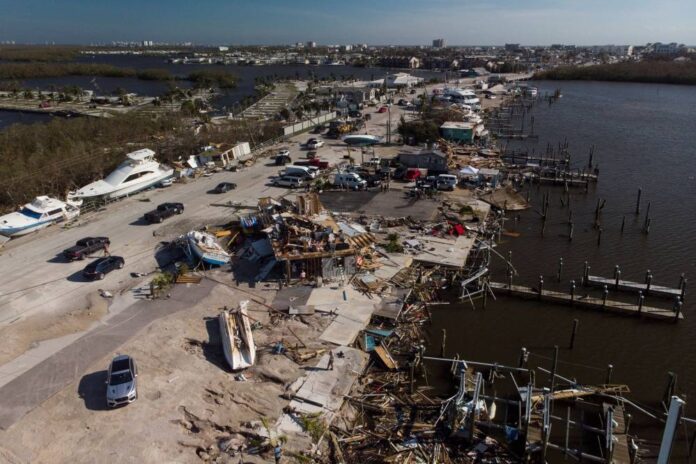A destroyed marina is seen after Hurricane Ian caused widespread destruction in Fort Myers Beach, Florida US September 29, 2022. – Reuters pic
Follow us on Instagram, subscribe to our Telegram channel and browser alerts for the latest news you need to know.
VENICE (Florida), Sept 30 – Emergency crews raced yesterday to reach stranded Florida residents as Hurricane Ian trained its sights on the Carolinas after cutting a coast-to-coast path of destruction across Florida, leaving behind deadly floodwaters, downed power lines and widespread damage.
Ian, one of the strongest storms ever to hit the US mainland, flooded Gulf Coast communities and knocked out power to millions before plowing across the peninsula to the Atlantic Ocean, where it regained strength ahead of another anticipated landfall in South Carolina today.
Florida’s death toll remained uncertain amid scattered reports of casualties.
President Joe Biden, speaking at Federal Emergency Management Agency (FEMA) headquarters in Washington, said Ian could prove to be the deadliest in state history.
“The numbers are still unclear, but we’re hearing early reports of what may be substantial loss of life,” Biden said.
In hard-hit Charlotte County, a spokesperson for the sheriff’s department confirmed multiple deaths but did not have a firm figure. Authorities in Sarasota County were investigating two possible storm-related deaths, a sheriff’s spokesperson said.
A 72-year-old man in Deltona in central Florida died after he went outside during the storm to drain his pool, authorities said.
More than 2.6 million homes and businesses in Florida remained without power. Governor Ron DeSantis said that Lee and Charlotte counties, home to more than 900,000 people, were “basically off the grid.”
Georgia, South Carolina and North Carolina were bracing for impact, as Ian – which weakened to a tropical storm during its trek across Florida – returned to hurricane strength by 5pm ET (2100 GMT), with maximum sustained wind speeds of 75 miles per hour (120km per hour), the US National Hurricane Center said.
The storm was churning off Florida’s eastern coast, about 240 miles (540km) south of Charleston, South Carolina. A hurricane warning was in effect for approximately 230 miles (370km) of coastline from the South Carolina-Georgia border north to Cape Fear, North Carolina.
In South Carolina, Mercedes Benz, Boeing Co, and the seaports that support manufacturers will suspend operations on Friday.
The coastal city of Savannah, Georgia, could start feeling tropical storm force winds later Thursday or early Friday. Ian was expected to bring potential life-threatening storm surges and possible tornadoes to the region on Friday, the National Weather Service said.
Georgia Governor Brian Kemp, who has already declared a statewide emergency, was scheduled to address residents early today.
Searching for survivors
Ian blasted ashore in Florida at the barrier island of Cayo Costa on Wednesday afternoon as a Category 4 hurricane with maximum sustained winds of 150 miles per hour (241 km per hour).
The storm transformed Florida’s southwestern shoreline, dotted with sandy beaches, coastal towns and mobile home parks, into a disaster zone as Ian swept seawater into waterfront homes.
“Sanibel Island is destruction … it got hit with really biblical storm surge. It washed away roads. It washed away structures,” DeSantis said during a news briefing as he described the damage sustained by the popular vacation destination.
He said earlier that 28 helicopters were performing water rescues and that the bridge to the island was impassable.
By midday yesterday, residents in hard-hit areas like Venice, located in Sarasota County about 75 miles (120 km) south of Tampa, hunted for family and friends while rescue crews worked to reach people trapped in flooded homes.
The search for loved ones was made more difficult as cellphone services were often cut.
“A lot of down trees, a lot of flooding everywhere. We are trying to get a hold of my daughter,” said Terri Byrd, as she tried to get cell service in a Walmart parking lot after spending the night at a Venice elementary school.
In Punta Gorda, a town directly in the hurricane’s path, trees, debris and power lines covered roadways, though many buildings remained standing, having withstood the storm’s onslaught better than many had feared.
“It was insane,” local landscaper Jeffrey Chambers, 53, said, describing sideways rain that erased all visibility. “I was like ‘Please stop already, just stop.’ And it kept going and going.”
Brenda Siettas, 62, a paraprofessional who works with students, was in the city in 2004 when Hurricane Charley blasted much of her neighborhood away. Buildings constructed since then are more able to survive high winds, she said.
“They definitely built back much better since Charley,” she said. “Back then I stayed here for two weeks: no power, no water, no sewer.”
Biden spoke to DeSantis yesterday, saying his administration was committed to close coordination and that Federal Emergency Management Agency Director Deanne Criswell will be in Florida today. Biden said that he will travel to the state when conditions allow.
Biden also approved a disaster declaration, making federal resources available to the counties impacted by the storm. – Reuters


